Biological reference intervals of lipid profile
Abstract
Introduction: the classification of the concentration of any analyte as pathological or not, implies that the measurement be compared to values of similarndividuals, for which is necessary to obtain Biological Reference Intervals (BRI). The BRI of lipid profile adopted by clinical laboratories are mainly the offered by commercial houses and those obtained by expert panels. In addition to the limited literature on BRI of lipid profile for our population, it is appropriate to specify that variables such as sex and age may be related to changes in lipid metabolism. Objective: to estimate the biological reference intervals of lipid profile in a population treated at a laboratory in Medellin. Methods: descriptive cross-sectional study in 81 healthy individuals; BRI were estimated from statistical X ± [Za / 2 * (DE / ? n)], 95% confidence and accuracy of 5%. Anova and t Student test was used in the bivariate analysis. Everything was done in SPSS 21.0®. In the BRI of men and women differences were only found in total cholesterol levels and total / HDL cholesterol and triglycerides / HDL cholesterol. Analyzing age groups, differences in triglycerides and VLDL-C were found, being these lower in young adults compared with the middle-aged adults and the elderly; for index triglycerides / VLDL cholesterol difference between young and older adults was found. Conclusion: this study allowed determining the BRI of lipid profile, which are important for designing strategies for primary prevention of dyslipidemia in the studied population.Metrics
Metrics Loading ...
Published
2016-06-23
How to Cite
Galvis, Y., Barona Acevedo, J., & Cardona Arias, J. A. (2016). Biological reference intervals of lipid profile. Acta Médica Colombiana, 41(1), 29-35. https://doi.org/10.36104/amc.2016.591
Issue
Section
Original works
Acta Medica Colombiana uses the CC-BY 4.0 license. Authors retain all rights over their work.


